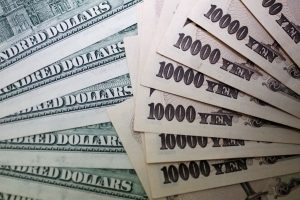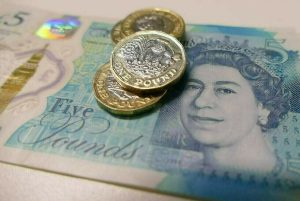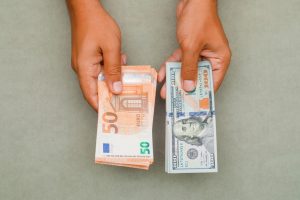DOLLAR HITS 15-WEEK HIGH AGAINST YEN AS CONSUMER PRICES GAIN
The dollar reached a 15-week high against the Japanese yen on Tuesday as U.S. consumer prices increased by the most in five months in June, while traders also pared expectations on how many times the Federal Reserve is likely to cut interest rates this year. Fed funds traders are pricing in 44 basis points of cuts by year-end, down from around 48 basis points before the data, with the first-rate reduction still expected in September. “A slightly softer-than-expected June core inflation reading keeps alive the chances of a September Federal Reserve interest rate cut, but the risk is that we get less benign prints for July and August,” James Knightley, chief international economist, US at ING said in a note. “That means we will need to see clear evidence of softer jobs figures to trigger Fed action before December.” The dollar gained broadly in what was also a seen as a technical move as the greenback consolidated from a selloff that has sent the index down by around 9% this year. Brad Bechtel, global head of FX at Jefferies, noted that the dollar index is approaching technical targets including the 50-day moving average and the 100-price level. “I think some of this is just your normal run-of-the-mill technical consolidation,” he said. Nvidia was also set to resume artificial intelligence chip sales to China, in a sign of improving trade relations. “Some of that softening of China trade rhetoric is helping things at the margin,” Bechtel said. The euro was last down 0.51% on the day at $1.1603, the lowest since June 25. Against the Japanese yen, the dollar strengthened 0.77% to 148.84, the highest since April 3. Sterling weakened 0.28% to $1.3389, the lowest since June 23. The dollar weakened after Trump in April announced larger than expected tariffs but then delayed many of the levies pending negotiations with trading partners. Trump last week announced higher tariffs would come into effect on August 1 for imports from a range of countries, including Mexico, Japan, Canada and Brazil, and the European Union, though market reaction this time was relatively muted. “The market is ignoring the tariffs until it becomes clear whether there’s going to be sort of a major escalation like there was with China in April or if this is just yet another step on the way to some sort of deal,” said Steve Englander, head of global G10 FX research and North America macro strategy at Standard Chartered Bank’s NY Branch. In addition to tariffs and inflation, markets are also focused on the U.S. fiscal and debt outlook, and the pressure the Trump administration is placing on Powell as he keeps rates on hold.

POUND EDGES UP AHEAD OF US DATA AND BAILEY SPEECH
The pound steadied on Tuesday, following the previous day’s slide, in line with a more upbeat tone across the broader markets, ahead of U.S. inflation data and a speech by Bank of England Governor Andrew Bailey later. Sterling was last at $1.3435; little changed on the day and was similarly steady against the euro, which traded at 86.92 pence. Bailey will give his annual “Mansion House” address to London’s financial sector on Tuesday, along with finance minister Rachel Reeves. The pound is still up 7.6% against the dollar this year, but it has lost over 5% in value against the euro, set for its weakest annual performance since 2022, when UK markets were hit by a crisis triggered by an interim budget from former Prime Minister Liz Truss. Losses against the euro have accelerated in recent weeks. In the last two months, sterling has lost over 3.5%. Investor concern over the outlook for the UK economy, which contracted unexpectedly for a second month in a row in May, is building, especially considering the shrinking fiscal headroom that Reeves has after the government watered down a landmark reform to welfare benefits and passed a bill that blew a hole in its finances. “That round of cuts left a 5 billion-pound ($6.72 billion) hole in public finances, one which the government seems unconfident in fixing with more cuts. All of this means that the pound is under pressure on the fiscal credibility front, not Liz Truss by any means, but a serious drag on sterling’s value,” Caxton FX strategist David Stritch said. Money markets show traders are looking for at least two quarter-point rate cuts this year from 4.25%, which implies rates at 3.6% by December. Just two months ago, markets showed the implied rate for December was closer to 4%.”Expect Governor Bailey to reiterate a position – similar to the Fed – that faster easing is possible if the labour market deteriorates,” ING strategist Chris Turner said in a note. Investors are waiting for U.S. consumer inflation later Tuesday t hat could be key in setting expectations for where U.S. rates will head over the coming Federal Reserve meetings. There is also UK consumer inflation on Wednesday that is expected to show price pressures continued to accelerate in June.
STERLING EDGES HIGHER VERSUS DOLLAR, BETS ON RATE CUTS IN FOCUS
The pound edged higher against a weakening dollar and fell versus the euro, as investors assessed whether the Bank of England might cut rates more aggressively than the currently expected pace of 25 basis points per quarter. Britain’s annual rate of consumer price (CPI) inflation unexpectedly rose to its highest in over a year at 3.6% in June. “The bar to cutting rates faster still feels fairly high,” said Francesco Pesole, a forex strategist at ING. “The risks associated with tomorrow’s jobs numbers are probably preventing any larger hawkish repricing in the Sonia curve (after CPI data) and, by extension, keeping the British pound’s gains contained,” he added. Data showed last week Britain’s economy contracted unexpectedly for a second month running in May. Sterling was last up 0.05% at $1.3390, after hitting $1.3397 on Tuesday, its lowest level since June 23. The dollar edged down against the euro and yen on Wednesday, after hitting multi-week highs the day before, as investors awaited producer price data later in the session for further clues about potential tariff-driven inflation. “Today’s data won’t give the Monetary Policy Committee (MPC) any sense of comfort on the inflation side,” said Sanjay Raja, chief UK economist at Deutsche Bank, arguing that tomorrow’s job figures “may hold more weight when it comes to shaping the monetary policy outlook.” “The bar for a dovish surprise on tomorrow’s labour market data will likely rise on the back of today’s inflation reading.” Markets priced in an 80% chance of a 25 bps rate cut in August, more than 50 bps by year-end and 75 bps by April 2026. Yields on 10-year gilts rose 1.5 bps to 4.65%. BoE Governor Andrew Bailey, on Tuesday, focused his speech on the International Monetary Fund’s role in addressing the accumulation of risky imbalances in the global economy, many of which originate from the United States and China. Sterling dropped 0.1% versus the euro to 86.75 pence. It hit 86.96 per euro on Tuesday, its lowest level since April 11.

DOLLAR DROPS VERSUS EURO AND YEN, U.S. PPI DATA IN FOCUS
The dollar fell versus the euro and yen on Wednesday after hitting multi-week highs the day before, as U.S. data pointed to tariff-driven inflation prompting investors to slightly scale back their bets on Federal Reserve rate cuts. Rising prices on goods as varied as coffee, audio equipment and home furnishings pulled the inflation rate higher in June, with substantial increases in prices of heavily imported items. That shored up the dollar and pushed U.S. rates higher, with the benchmark 10-year yield down one basis point in London trade to 4.48%, after hitting 4.491% on Tuesday, its strongest level since June 11. Investors are now pricing in roughly 44 bps worth of Fed easing by December, down from just above 50 bps at the start of the week. Against the yen, the greenback was down 0.1% at 148.65 after hitting a 3-1/2-month peak of 149.19. The euro snapped a 5-day losing streak and was up 0.20% at $1.1625. Sterling rose 0.15% to $1.3405 after hitting a three-week low the day before. “Higher tariff-related goods inflation justifies their (the Fed) more cautious stance, while continued disinflation across services categories should support rate cuts in September and beyond,” said Tiffany Wilding, economist at PIMCO. “We believe the fact that inflation is more concentrated in core goods categories will make it easier for the Fed to communicate why they are cutting rates while inflation is above target,” she added. However, the market focus is now on U.S. producer price data to be released later in the day for further clues on whether price pressures are indeed beginning to pick up. Against a basket of currencies, the dollar fell 0.16% to 98.46. Also weighing on investors’ minds was the prospect that Fed Chair Jerome Powell’s eventual successor could be someone more inclined to lower interest rates. Trump has railed against Powell for months for not easing and repeatedly urged him to resign. On Tuesday, Trump said cost overruns on a $2.5 billion renovation of the Fed’s Washington headquarters could amount to a firing offence. “Trump’s attacks on the Fed’s independence are unlikely to stop,” said Michael Pfister, forex analyst at Commerzbank. “A 25-basis-point cut is unlikely to satisfy him given that he is demanding 300 basis points lower rates. Accordingly, the current recovery phase (of the U.S. dollar) is unlikely to last long as well,” he added. In trade, Indonesia said on Wednesday it had reached a deal with the United States after an “extraordinary struggle” in negotiations which resulted in a reduction of proposed U.S. tariff rates on Indonesian goods to 19% from 32%. Trump separately said on Tuesday that a trade agreement with Vietnam was nearly complete. He also said more deals were coming, while offering fresh details on planned duties on pharmaceuticals.

BATTERED DOLLAR A BOON FOR U.S. MULTINATIONAL COMPANIES
Large U.S. multinationals should soon start showing the positive effects of the dollar’s tumble in recent months, reversing the situation in the past few years when the greenback’s strength hurt companies with significant foreign revenue. The Dollar Index, which measures the buck’s strength against six major currencies, is down about 10% for the year, due to rapidly changing U.S. trade policy and worries about U.S. growth and government debt. About half of that drop happened since April 2, when U.S. President Donald Trump announced outsized import tariffs against trading partners that started a panic about investing in U.S. assets. For the April-June period, the index, which is heavily weighted toward the euro, averaged 99.74, down 6.5% from the first quarter average, the largest such decline over consecutive quarters in more than 30 years. The effects of the dollar’s slide are expected to start showing up in second-quarter earnings season just getting underway. While that dollar’s fall reflects investor worries about the U.S. economy’s strength, it can help some companies. A weaker U.S. currency makes it cheaper for multinational companies to convert foreign profits into dollars, while also boosting the competitiveness of exporters’ products. “It’s an absolutely huge move,” Greg Boutle, head of U.S. equity & derivative strategy at BNP Paribas, said. “It is going to flatter earnings a little bit this quarter and also feed its way to guidance.” The dollar’s impact on overall earnings is usually small but can grow more meaningful when the currency experiences a large swing. Every 10% drop in the dollar translates into a profit surprise of about 2%, at the S&P 500 level, according to estimates from research and strategy firm Macro Hive. That would be welcomed by investors increasingly worried about the earnings impact of evolving trade and tariff policies. The second-quarter profit reporting season started this week. “Whatever the beat, miss or forward guidance was going to be without the FX effect will obviously be a little bit better with it,” Boutle said. The dollar’s weakness this year, after a 7% rise in 2024, which hurt corporate results last year, took many market watchers by surprise. “Certainly, a lot of companies came into the year assuming a headwind …. That’s flipped. That’s a positive for earnings,” Patrick Kaser, portfolio manager at Brandywine Global, said. While earnings growth is expected to decelerate from the first quarter, the weaker dollar could help to offset possible tariff effects. Analysts are forecasting second-quarter earnings growth of 5.8% year-over-year compared with 13.7% in the first quarter, LSEG data show. Even in the first quarter, the dollar was a drag on year-over-year S&P 500 earnings growth of about 1% but now could lift earnings growth by about 0.5% in the second quarter, according to David Lefkowitz, head of U.S. equities at UBS Global Wealth Management. “If the dollar stays at these levels, the boost on a year-over-year basis will get progressively larger,” Lefkowitz said, estimating the dollar could generate a lift to year-over-year S&P 500 earnings growth by about 1% and 1.5% for the third and fourth quarter respectively.
- CAPITALDIGEST MARKET REVIEW , 03/11/2025November 3, 2025
- CAPITALDIGEST DAILY NEWS, 03/11/2025November 3, 2025
- CAPITALDIGEST MARKET REVIEW, 22/09/2025September 22, 2025
Enter your email address for receiving valuable newsletters.
- CAPITALDIGEST DAILY NEWS, 03/11/2025NNPCL WEIGHS OVERHAUL, REPURPOSING OPTIONS FOR REFINERIES The Nigerian National Petroleum Company Limited has said...November 3, 2025
- CAPITALDIGEST MARKET REVIEW, 22/09/2025STERLING RISES AGAINST DOLLAR ON FED-BOE POLICY DIVERGENCE Sterling gained against the dollar on Tuesday,...September 22, 2025
- CAPITALDIGEST DAILY NEWS, 22/09/2025OIL REFORMS DRIVE $18.2BN DEALS – FG Nigeria’s oil and gas sector is experiencing a...September 22, 2025












